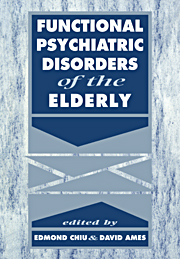Book contents
- Frontmatter
- Contents
- List of contributors
- Preface
- Introduction – A personal note
- Acknowledgement
- Part 1 Classification
- Part 2 General epidemiology
- Part 3 Neuroses
- Part 4 Affective disorders
- Part 5 Psychosexual disorders
- Part 6 Substance use and abuse
- Part 7 Schizophrenia and related psychoses
- 17 The elderly with schizophrenia
- 18 Late onset paranoid disorders:
- 19 Community or asylum? finding a place to care for the elderly psychiatric patient
- Part 8 Psychological, biological and medical issues
- Part 9 Treatment methods
- Part 10 Conclusion
- Index
19 - Community or asylum? finding a place to care for the elderly psychiatric patient
from Part 7 - Schizophrenia and related psychoses
Published online by Cambridge University Press: 13 November 2009
- Frontmatter
- Contents
- List of contributors
- Preface
- Introduction – A personal note
- Acknowledgement
- Part 1 Classification
- Part 2 General epidemiology
- Part 3 Neuroses
- Part 4 Affective disorders
- Part 5 Psychosexual disorders
- Part 6 Substance use and abuse
- Part 7 Schizophrenia and related psychoses
- 17 The elderly with schizophrenia
- 18 Late onset paranoid disorders:
- 19 Community or asylum? finding a place to care for the elderly psychiatric patient
- Part 8 Psychological, biological and medical issues
- Part 9 Treatment methods
- Part 10 Conclusion
- Index
Summary
Introduction
The average age of those patients still living in the large mental hospitals of the nineteenth and early twentieth centuries has steadily risen. These ‘old long-stay patients’ are often left behind in the hospital's remaining wards as younger more active patients are found places in community housing projects, group homes and psychiatric ‘hospital’ hostels (cf. Jones, 1989). Staff remaining behind with their patients are likely to be older and reluctant to contemplate finding a place for either themselves or their patients ‘in the community’. Should the mental health services continue to offer an asylum to these ageing schizophrenic patients whose adult life may well have been shaped by past institutional regimes? Are sheltered work opportunities or group living attractive options for these retirement-age patients? Does living in the community offer any real improvement in the quality of life for an elderly ex-asylum inmate? Or is a hostel or nursing home nothing more than a miniature asylum in the community, a parish madhouse replacing the county asylum? The aim of this chapter is to examine the empirical evidence and consider the policy options surrounding the move out of the asylum for the elderly person with chronic schizophrenia.
The decline of the psychiatric hospital
The number of mental hospital beds in both the United States and Europe has been reducing steadily in recent years and this downward trend seems to be accelerating. What happens to these disappearing patients is a question of concern to clinicians and policy makers alike.
- Type
- Chapter
- Information
- Functional Psychiatric Disorders of the Elderly , pp. 326 - 340Publisher: Cambridge University PressPrint publication year: 1994



